roof TOYOTA SUPRA 2023 Owners Manual
[x] Cancel search | Manufacturer: TOYOTA, Model Year: 2023, Model line: SUPRA, Model: TOYOTA SUPRA 2023Pages: 372, PDF Size: 6.32 MB
Page 41 of 372
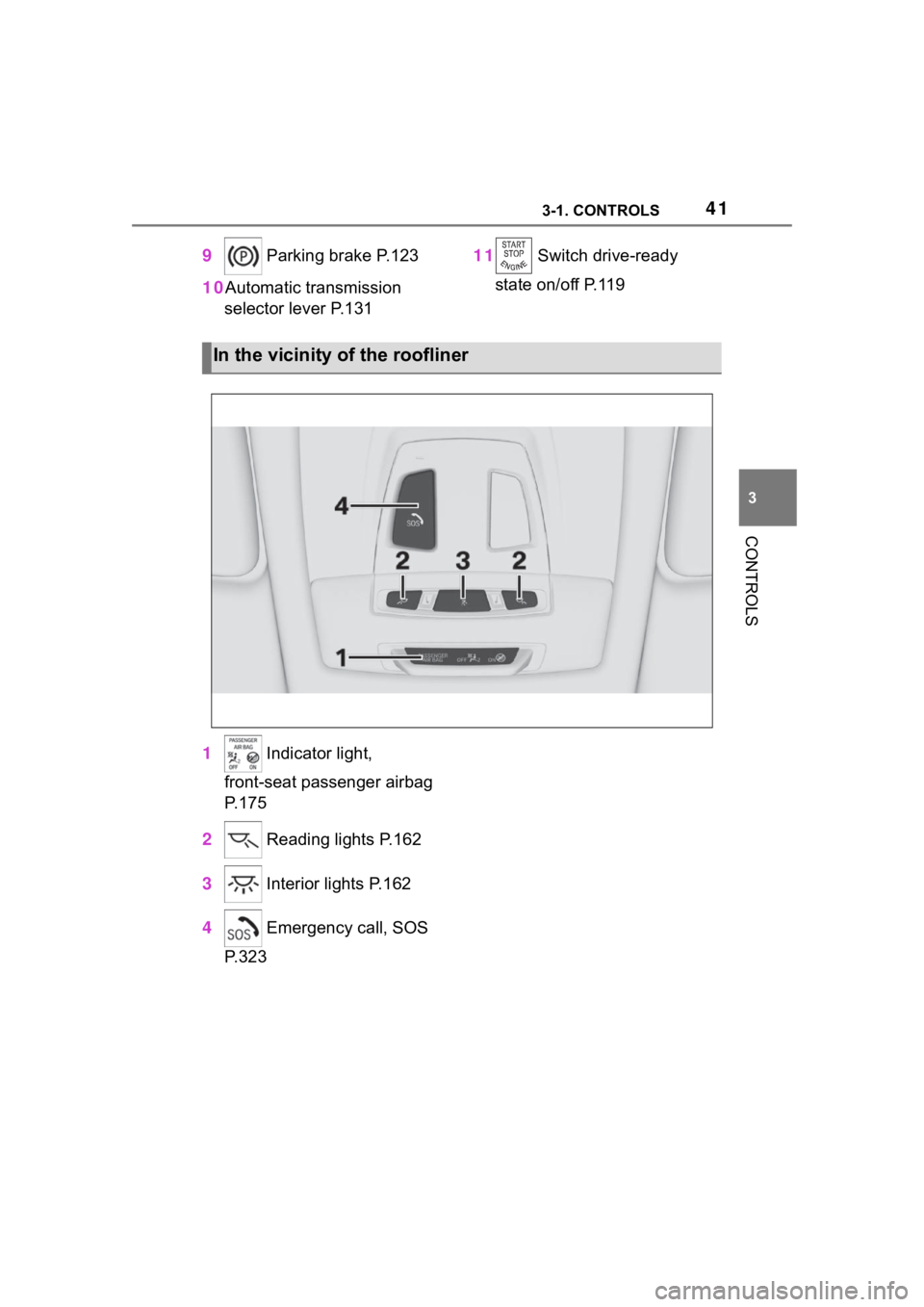
413-1. CONTROLS
3
CONTROLS
9 Parking brake P.123
10 Automatic transmission
selector lever P.131 11
Switch drive-ready
state on/off P.119
1 Indicator light,
front-seat passenger airbag
P.175
2 Reading lights P.162
3 Interior lights P.162
4 Emergency call, SOS
P.323
In the vicinity of the roofliner
Page 175 of 372
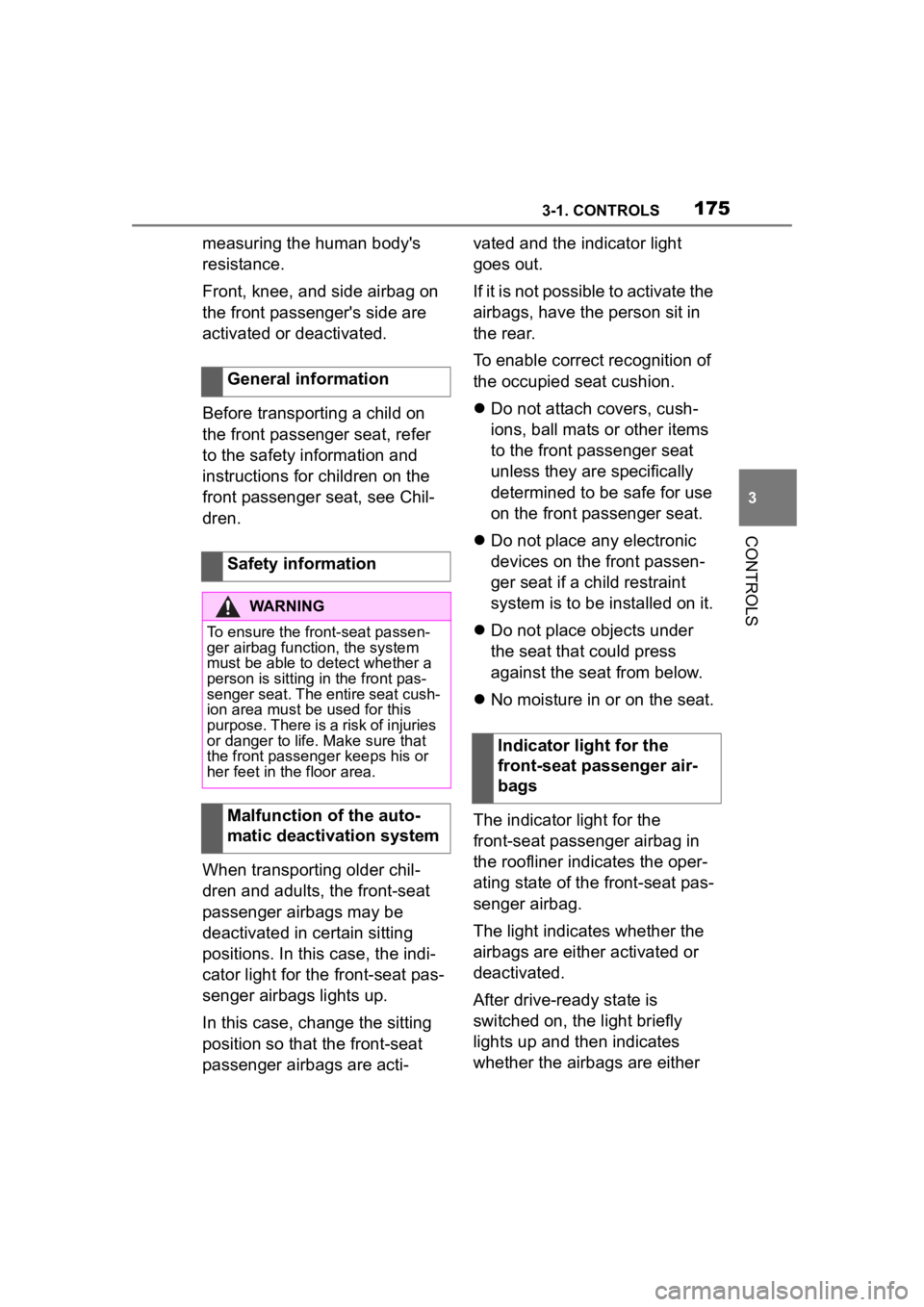
1753-1. CONTROLS
3
CONTROLS
measuring the human body's
resistance.
Front, knee, and side airbag on
the front passenger's side are
activated or deactivated.
Before transporting a child on
the front passenger seat, refer
to the safety information and
instructions for children on the
front passenger seat, see Chil-
dren.
When transporting older chil-
dren and adults, the front-seat
passenger airbags may be
deactivated in certain sitting
positions. In this case, the indi-
cator light for the front-seat pas-
senger airbags lights up.
In this case, change the sitting
position so that the front-seat
passenger airbags are acti-vated and the indicator light
goes out.
If it is not possible to activate the
airbags, have the person sit in
the rear.
To enable correct recognition of
the occupied seat cushion.
Do not attach covers, cush-
ions, ball mats or other items
to the front passenger seat
unless they are specifically
determined to be safe for use
on the front passenger seat.
Do not place any electronic
devices on the front passen-
ger seat if a child restraint
system is to be installed on it.
Do not place objects under
the seat that could press
against the seat from below.
No moisture in or on the seat.
The indicator light for the
front-seat passenger airbag in
the roofliner indicates the oper-
ating state of the front-seat pas-
senger airbag.
The light indicates whether the
airbags are either activated or
deactivated.
After drive-ready state is
switched on, the light briefly
lights up and then indicates
whether the airbags are either
General information
Safety information
WARNING
To ensure the front-seat passen-
ger airbag function, the system
must be able to detect whether a
person is sitting
in the front pas-
senger seat. The entire seat cush-
ion area must be used for this
purpose. There is a risk of injuries
or danger to life. Make sure that
the front passeng er keeps his or
her feet in the floor area.
Malfunction of the auto-
matic deactivation system
Indicator light for the
front-seat passenger air-
bags
Page 200 of 372
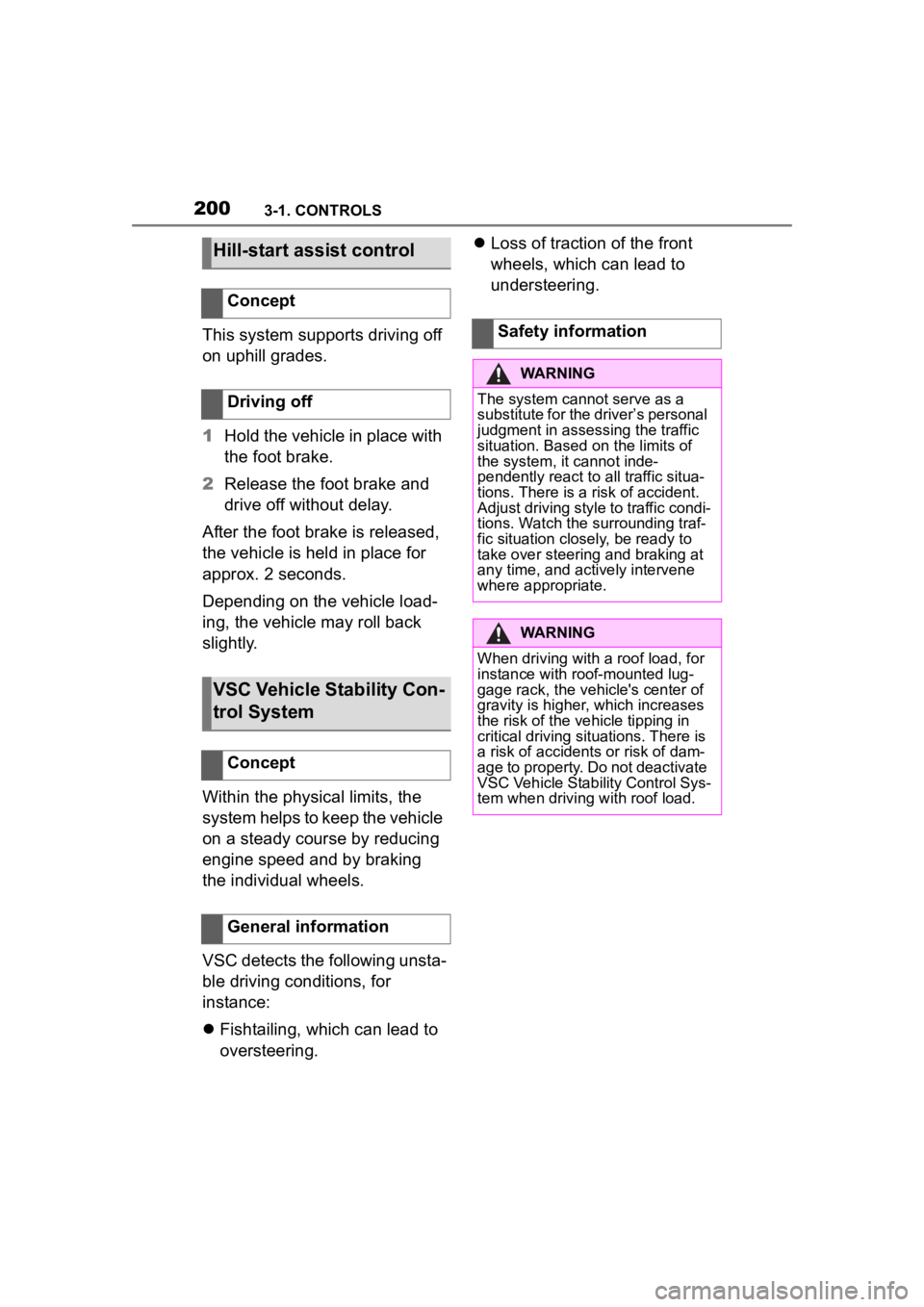
2003-1. CONTROLS
This system supports driving off
on uphill grades.
1Hold the vehicle in place with
the foot brake.
2 Release the foot brake and
drive off without delay.
After the foot brake is released,
the vehicle is held in place for
approx. 2 seconds.
Depending on the vehicle load-
ing, the vehicle may roll back
slightly.
Within the physical limits, the
system helps to keep the vehicle
on a steady course by reducing
engine speed and by braking
the individual wheels.
VSC detects the following unsta-
ble driving conditions, for
instance:
Fishtailing, which can lead to
oversteering.
Loss of traction of the front
wheels, which can lead to
understeering.
Hill-start assist control
Concept
Driving off
VSC Vehicle Stability Con-
trol System
Concept
General information
Safety information
WARNING
The system cannot serve as a
substitute for the driver’s personal
judgment in assessing the traffic
situation. Based on the limits of
the system, it cannot inde-
pendently react to all traffic situa-
tions. There is a risk of accident.
Adjust driving style to traffic condi-
tions. Watch the surrounding traf-
fic situation closely, be ready to
take over steering and braking at
any time, and actively intervene
where appropriate.
WARNING
When driving with a roof load, for
instance with roof-mounted lug-
gage rack, the vehicle's center of
gravity is higher, which increases
the risk of the vehicle tipping in
critical driving sit uations. There is
a risk of accidents or risk of dam-
age to property. Do not deactivate
VSC Vehicle Stability Control Sys-
tem when driving with roof load.
Page 226 of 372
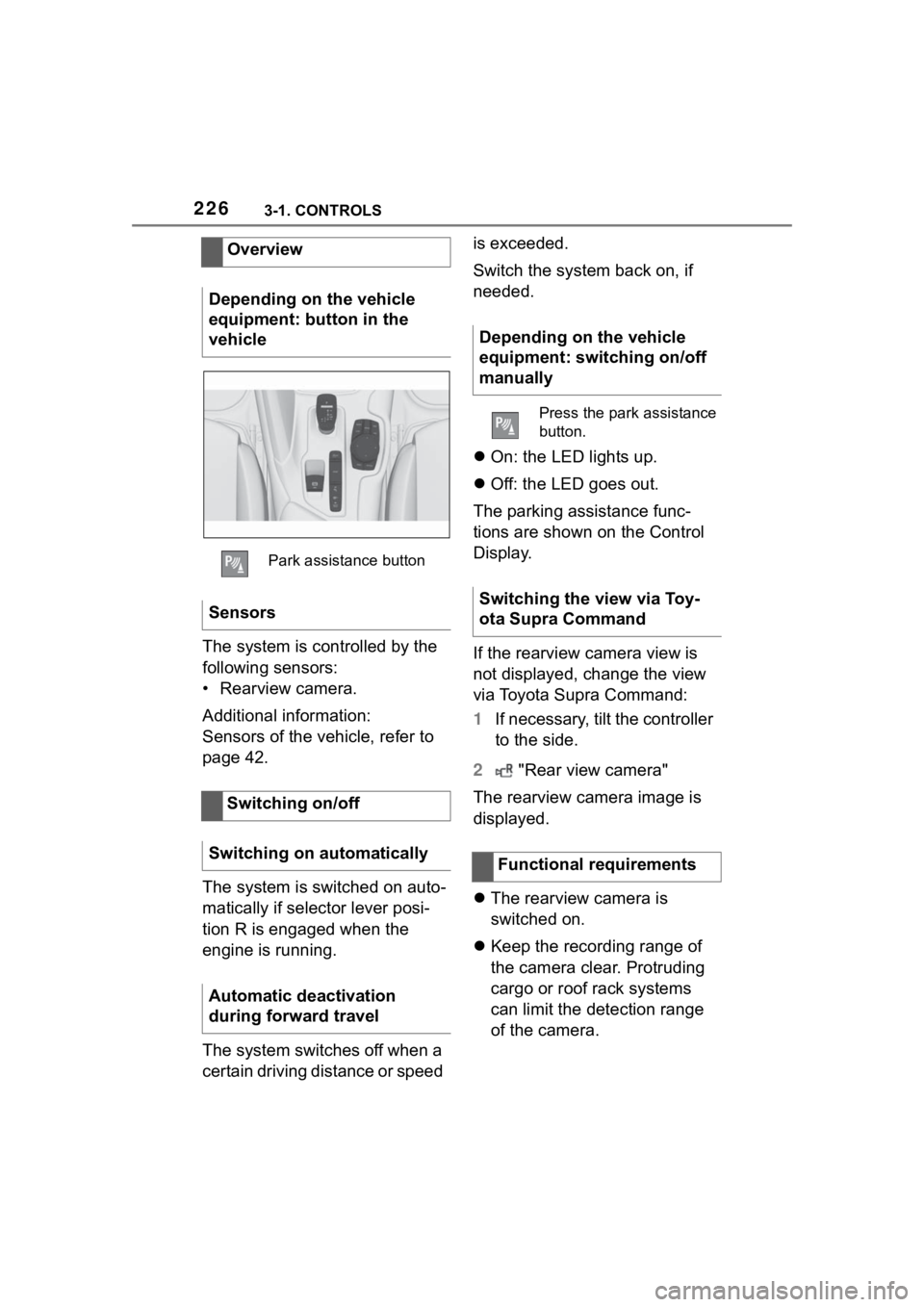
2263-1. CONTROLS
The system is controlled by the
following sensors:
• Rearview camera.
Additional information:
Sensors of the vehicle, refer to
page 42.
The system is switched on auto-
matically if selector lever posi-
tion R is engaged when the
engine is running.
The system switches off when a
certain driving distance or speed is exceeded.
Switch the system back on, if
needed.
On: the LED lights up.
Off: the LED goes out.
The parking assistance func-
tions are shown on the Control
Display.
If the rearview camera view is
not displayed, change the view
via Toyota Supra Command:
1 If necessary, tilt the controller
to the side.
2 "Rear view camera"
The rearview camera image is
displayed.
The rearview camera is
switched on.
Keep the recording range of
the camera clear. Protruding
cargo or roof rack systems
can limit the detection range
of the camera.
Overview
Depending on the vehicle
equipment: button in the
vehicle
Park assistance button
Sensors
Switching on/off
Switching on automatically
Automatic deactivation
during forward travel
Depending on the vehicle
equipment: switching on/off
manually
Press the park assistance
button.
Switching the view via Toy-
ota Supra Command
Functional requirements
Page 252 of 372
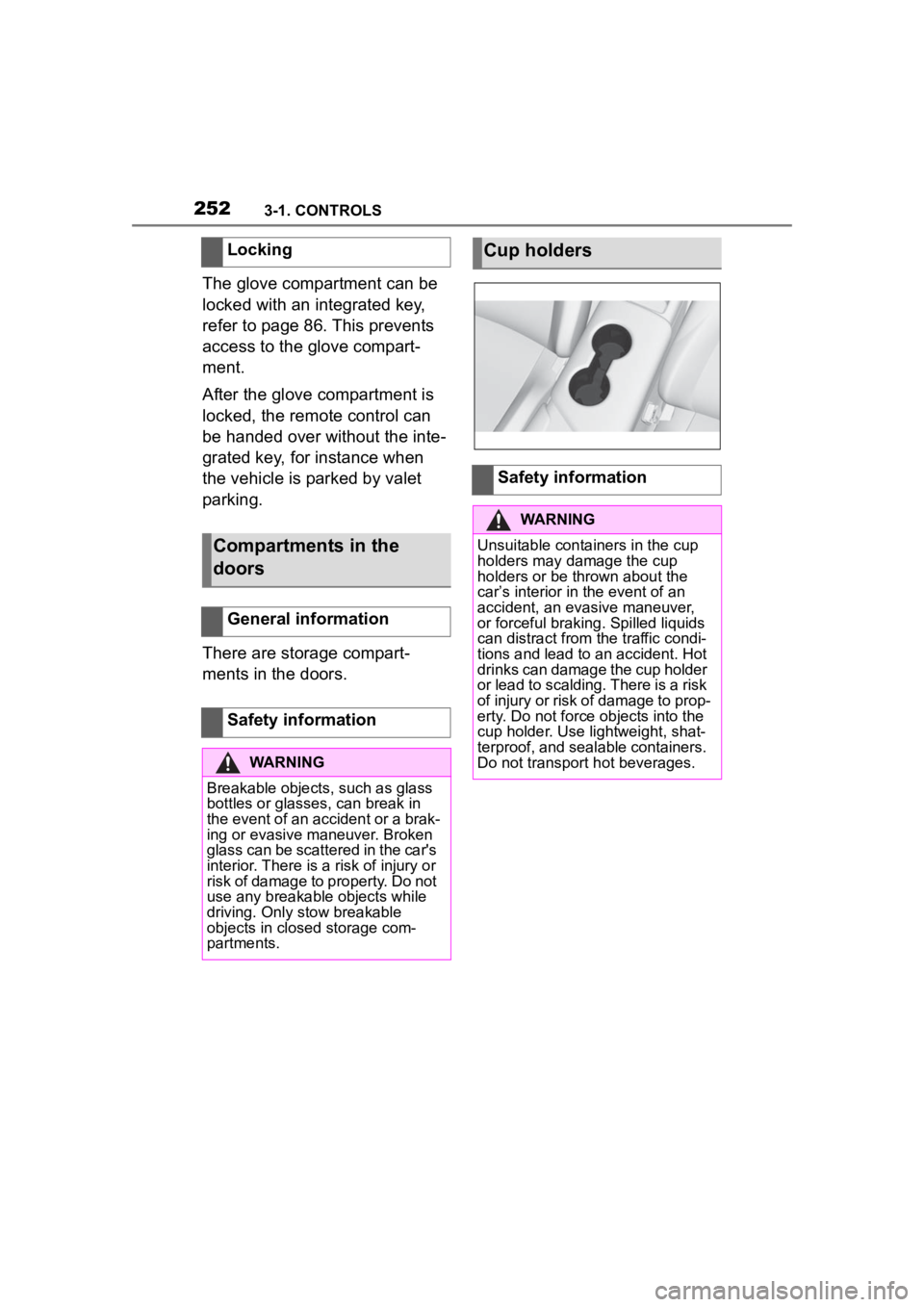
2523-1. CONTROLS
The glove compartment can be
locked with an integrated key,
refer to page 86. This prevents
access to the glove compart-
ment.
After the glove compartment is
locked, the remote control can
be handed over without the inte-
grated key, for instance when
the vehicle is parked by valet
parking.
There are storage compart-
ments in the doors.Locking
Compartments in the
doors
General information
Safety information
WARNING
Breakable objects, such as glass
bottles or glasses, can break in
the event of an accident or a brak-
ing or evasive maneuver. Broken
glass can be scattered in the car's
interior. There is a risk of injury or
risk of damage to property. Do not
use any breakable objects while
driving. Only stow breakable
objects in closed storage com-
partments.
Cup holders
Safety information
WARNING
Unsuitable containers in the cup
holders may damage the cup
holders or be thrown about the
car’s interior in the event of an
accident, an evasive maneuver,
or forceful braking. Spilled liquids
can distract from the traffic condi-
tions and lead to an accident. Hot
drinks can damage the cup holder
or lead to scalding. There is a risk
of injury or risk of damage to prop-
erty. Do not force objects into the
cup holder. Use lightweight, shat-
terproof, and sealable containers.
Do not transport hot beverages.
Page 335 of 372
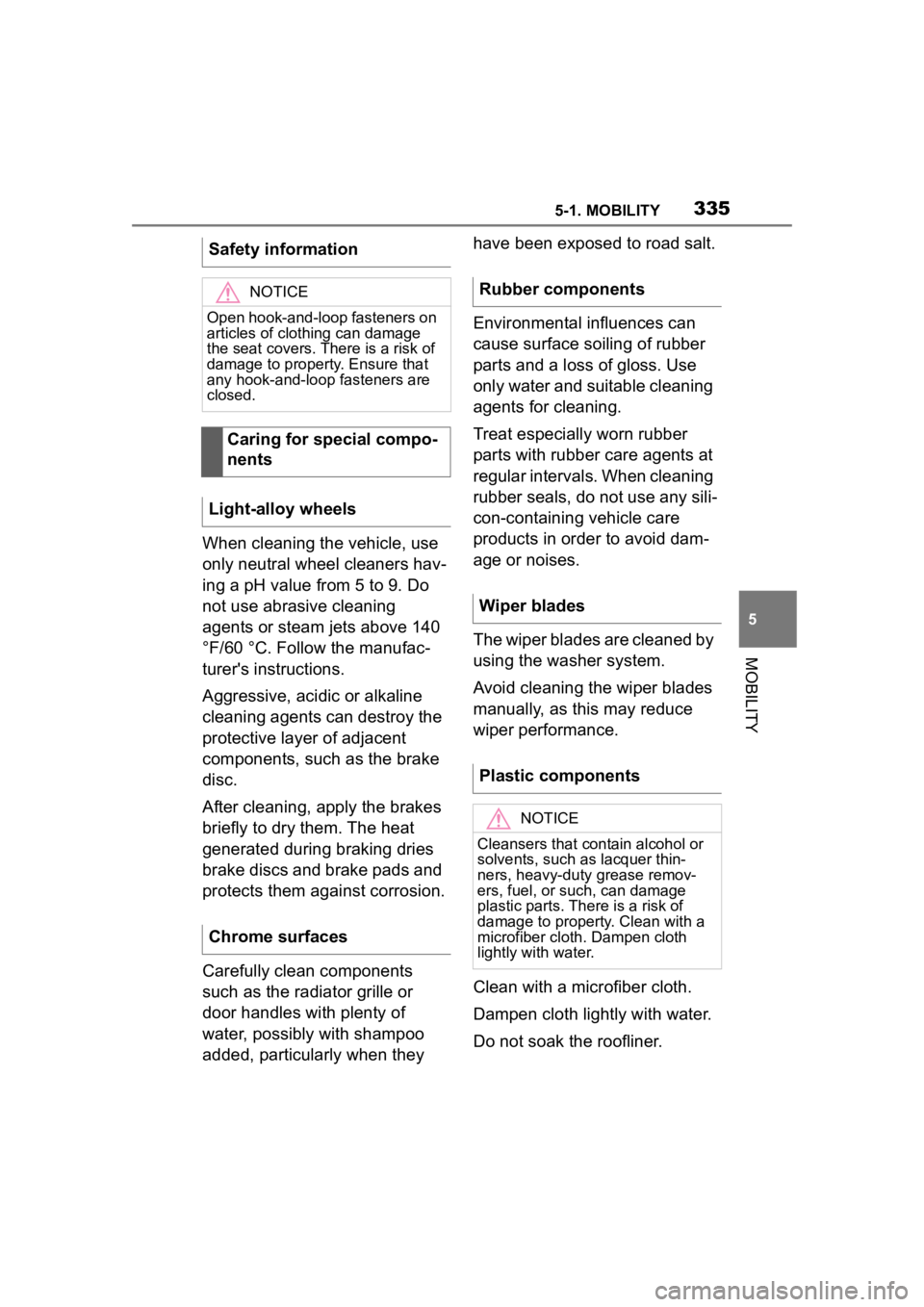
3355-1. MOBILITY
5
MOBILITY
When cleaning the vehicle, use
only neutral wheel cleaners hav-
ing a pH value from 5 to 9. Do
not use abrasive cleaning
agents or steam jets above 140
°F/60 °C. Follow the manufac-
turer's instructions.
Aggressive, acidic or alkaline
cleaning agents can destroy the
protective layer of adjacent
components, such as the brake
disc.
After cleaning, apply the brakes
briefly to dry them. The heat
generated during braking dries
brake discs and brake pads and
protects them against corrosion.
Carefully clean components
such as the radiator grille or
door handles with plenty of
water, possibly with shampoo
added, particularly when they have been exposed to road salt.
Environmental influences can
cause surface soiling of rubber
parts and a loss of gloss. Use
only water and suitable cleaning
agents for cleaning.
Treat especially worn rubber
parts with rubber care agents at
regular intervals. When cleaning
rubber seals, do not use any sili-
con-containing vehicle care
products in order to avoid dam-
age or noises.
The wiper blades are cleaned by
using the washer system.
Avoid cleaning the wiper blades
manually, as this may reduce
wiper performance.
Clean with a microfiber cloth.
Dampen cloth lightly with water.
Do not soak the roofliner.
Safety information
NOTICE
Open hook-and-loop fasteners on
articles of clothing can damage
the seat covers. There is a risk of
damage to propert
y. Ensure that
any hook-and-loop fasteners are
closed.
Caring for special compo-
nents
Light-alloy wheels
Chrome surfaces
Rubber components
Wiper blades
Plastic components
NOTICE
Cleansers that contain alcohol or
solvents, such as lacquer thin-
ners, heavy-duty grease remov-
ers, fuel, or such, can damage
plastic parts. Ther e is a risk of
damage to property. Clean with a
microfiber cloth. Dampen cloth
lightly with water.
Page 340 of 372
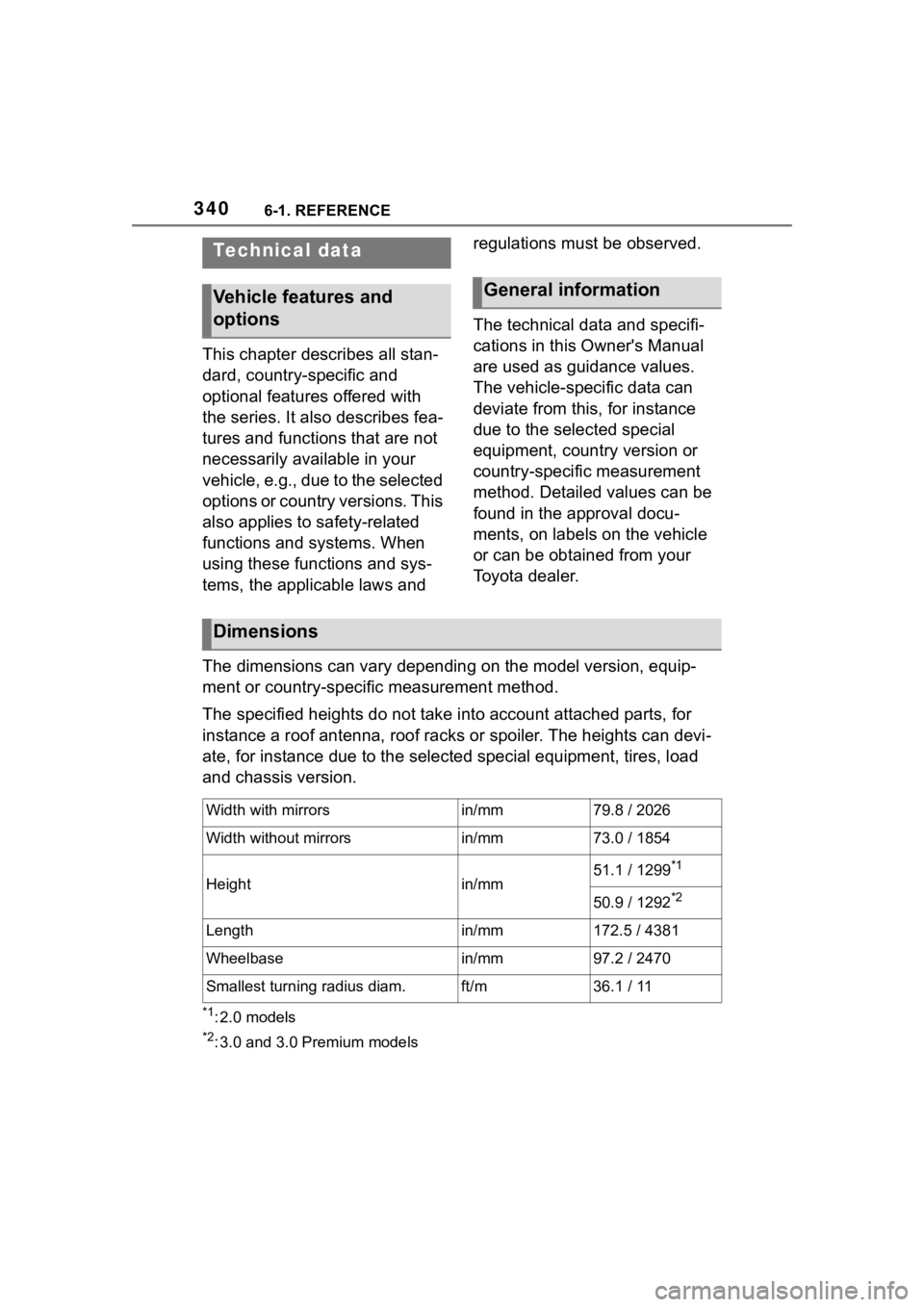
3406-1. REFERENCE
6-1.REFERENCE
This chapter describes all stan-
dard, country-specific and
optional features offered with
the series. It also describes fea-
tures and functions that are not
necessarily available in your
vehicle, e.g., due to the selected
options or country versions. This
also applies to safety-related
functions and systems. When
using these functions and sys-
tems, the applicable laws and regulations must be observed.
The technical data and specifi-
cations in this Owner's Manual
are used as guidance values.
The vehicle-specific data can
deviate from this, for instance
due to the selected special
equipment, country version or
country-specific measurement
method. Detailed values can be
found in the approval docu-
ments, on labels on the vehicle
or can be obtained from your
Toyota dealer.
The dimensions can vary depending on the model version, equip-
ment or country-specific measurement method.
The specified heights do not take into account attached parts, for
instance a roof antenna, roof racks or spoiler. The heights can devi-
ate, for instance due to the selected special equipment, tires, load
and chassis version.
*1: 2.0 models
*2: 3.0 and 3.0 Premium models
Technical data
Vehicle features and
optionsGeneral information
Dimensions
Width with mirrorsin/mm79.8 / 2026
Width without mirrorsin/mm73.0 / 1854
Heightin/mm51.1 / 1299*1
50.9 / 1292*2
Lengthin/mm172.5 / 4381
Wheelbasein/mm97.2 / 2470
Smallest turning radius diam.ft/m36.1 / 11
Page 369 of 372

369Alphabetical Index
RES CNCL button, see Dynamic radar cruise control with
full-speed range ................... 209
Reserve warning, see Range 146
Reset, Tire Pressure Monitor TPM........................................ 291
Retreaded tires ....................... 280
Reversing lights, bulb replace- ment, see Lights and bulbs . 312
Roadside Assistance, see Break- down assistance .................. 323
Roadside parking lights......... 158
Rolling code hand-held transmit- ter........................................... 243
RON recommended fuel grade ............................................... 301
Roof load capacity ................. 341
Roofliner ................................... 41
Rope for tow-starting/towing 329
Rubber components, care ..... 335
S
Safe braking ............................ 261
Safety belt warni ng for driver's
seat and front passenger seat ............................................... 107
Safety belts ............................. 103
Safety belts, care .................... 336
Safety systems, see Airbags . 164
Safety systems, see Toyota Supra Safety ......................... 176
Saving fuel .............................. 263
Screen Mirroring, connection . 77
Screen, see Control Display .... 51
Screwdriver, see Onboard vehi- cle tool kit ............................. 311
Sealant, see Mobility System 282
Seat heating ............................ 112
Seat, see Memory function .... 111
Seating position for children. 114
Seats, front ............................... 99
Securing cargo ....................... 254 Selection list in i
nstrument clus-
ter ...........................................148
Selector lever, Automatic trans- mission ..................................131
Sensors of the vehicle .............42
Sensors, care ..........................336
Service and warranty .................7
Service requirements .............147
Service requirements, see Condi- tion Based Service CBS .......309
SET button, see Cruise control ...............................................205
SET button, see D ynamic radar
cruise control with full-speed
range ......................................209
Set speed, see Dynamic radar cruise control with full-speed
range ......................................209
Settings on Control Display ....63
Settings, locking/unlocking .....93
Shift lever Manual transmission ............130
Shift paddles on the steering wheel .....................................131
Side airbag ..............................164
Side protection .. .....................223
Signaling, horn .........................38
Signals when unlocking, see Confirmation si gnals from the
vehicle .....................................94
Sitting safely .............................99
Sizes, see Dimensions ...........340
Smallest turning radius..........340
SMS text message, supplemen- tary .........................................140
Snow chains............................287
Socket for OBD Onboard Diagno- sis ..........................................309
Sockets ....................................245
SOS button, see Intelligent emer- gency call ..............................323